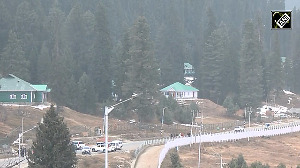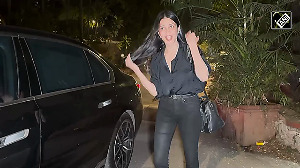On World Hypertension Day, Atmarpit Dr Mansiji lists 5 gentle yoga poses that ease stress, calm the mind and lower blood pressure naturally.

Yoga is not just about flexibility; it's about finding inner balance.
On World Hypertension Day, we bring attention to high blood pressure, a silent condition that affects millions and often goes unnoticed until it causes serious health concerns.
A consistent yoga practice that emphasises relaxation, breath awareness and gentle movement can help reduce stress, which is one of the major contributors to an increase in blood pressure.
The following five asanas are calming, grounding and known to activate the parasympathetic nervous system, encouraging a natural drop in tension, both physical and emotional.
1. Uttanasana (Standing Forward Fold)

Why practise this asana?
Uttanasana is a gentle inversion that calms the brain, soothes the nerves and encourages blood flow to the head without strain.
It's particularly effective for releasing stress and quieting an overactive mind.
How to practise it
- Stand tall with your feet hip-width apart.
- As you exhale, bend from your hips and extend from the base of your spine, ensuring a straight back and fold forward, letting your head hang down.
- Bend your knees slightly if need be to avoid strain in the lower back.
- Allow your arms to reach for the floor with your palms downwards or hold your shins.
- Stay for 5 to 8 breaths, focusing on lengthening the spine with each exhale.
Benefits
- Calms the nervous system.
- Reduces anxiety and fatigue.
- Improves circulation and lowers stress levels.
Contraindications
Avoid deep forward bending if you have glaucoma or very high uncontrolled blood pressure; practise under guidance.
2. Adho Mukha Svanasana (Downward-Facing Dog Pose)

Why practise this asana?
This mild inversion boosts circulation, elongates the spine and stretches the back body while inviting steady, conscious breathing, all of which are beneficial for managing hypertension.
How to practise it
- Begin in a tabletop position on your hands and knees.
- Tuck your toes, lift your knees and push the hips upward into an inverted V shape.
- Press your hands firmly and lengthen your spine.
- Push your heels toward the floor, feeling a stretch in the hamstrings.
- Breathe deeply for 5 to 8 counts and hold the pose.
Benefits
- Reduces stress and mental fatigue.
- Balances blood flow to the brain and heart.
- Energises while calming the body.
Contraindication
Those with vertigo or carpal tunnel syndrome should avoid holding the pose too long; consult a teacher for modifications.
3. Janu Sirsasana (Head-to-Knee Forward Bend)

Why practise this asana?
This seated forward bend soothes the mind and stretches the spine and hamstrings.
It's a go-to pose for stress reduction and inner quietude -- ideal for those managing high blood pressure.
How to practise it
- Sit with legs extended in Dandasana (seated with your back erect and legs extended).
- Bend one knee, bringing the sole of your foot to your inner thigh.
- Inhale, lengthen your spine; exhale, bend over your extended leg.
- Keep your back long, avoiding rounding of the back and hold the foot or the shin as comfortable.
- Hold for 5 to 8 counts on each side.
Benefits
- Calms the brain and heart rate.
- Stimulates liver and kidneys, supporting detoxification.
- Encourages introspection and restful awareness.
Contraindications
Anyone suffering from slipped disc, sciatica, hamstring or knee injury or hernia should avoid this pose. Use props as needed.
4. Virasana (Hero Pose)

Why practice this asana?
A grounding seated pose, Virasana allows for deep belly breathing, slows down your heart rate and brings a sense of stillness -- perfect for those seeking to lower blood pressure.
How to practise it
- Kneel down, bringing your knees together. Keep your feet slightly wider than your hips.
- Sit back between your heels, using a block or cushion if needed.
- Keep your spine tall and hands resting on your thighs in Chin Mudra (join the tip of your thumb with the tip of your index finger; the other fingers remain extended), facing upward.
- Breathe deeply for 5 to 8 counts and hold the pose.
Benefits
- Promotes mental peace and mindfulness.
- Aids digestion and reduces tension after meals.
- Encourages diaphragmatic breathing.
Contraindications
Not suitable for people with severe knee or ankle pain unless properly supported.
5. Setu Bandhasana (Bridge Pose)

Why practise this asana?
Setu Bandhasana helps open the chest and lungs while gently stimulating the parasympathetic nervous system. It's one of the best poses to reduce stress-related hypertension.
How to practise it
- Lie on your back with knees bent, feet hip-width apart.
- Press your feet down and lift your hips upward.
- Interlace your hands under your back and roll your shoulders in.
- Hold for 5 to 8 steady breaths, then slowly release.
Benefits
- Relieves fatigue and anxiety.
- Opens the heart space and improves circulation.
- Gently lowers blood pressure over time.
Contraindications
Avoid lifting too high if you have neck or lower back issues.
By embracing these calming postures and tuning into the rhythm of your breath, take a powerful step toward managing hypertension -- one mindful movement at a time.
Atmarpit Dr Mansiji, MD, is the head of SRMD Yoga. She is a paediatrician, neonatologist and a certified yoga trainer by Yoga Alliance. She conducts yoga, breathwork and meditation workshops globally.
Disclaimer: All content and media herein is written and published online for informational purposes only. It is not a substitute for professional medical advice. It should not be relied on as your only source for advice.
Please always seek the guidance of your doctor or a qualified health professional with any questions you may have regarding your health or a medical condition. Do not ever disregard the advice of a medical professional or delay in seeking it because of something you have read herein.
If you believe you may have a medical or mental health emergency, please call your doctor, go to the nearest hospital or call emergency services or emergency helplines immediately. If you choose to rely on any information provided herein, you do so solely at your own risk.











